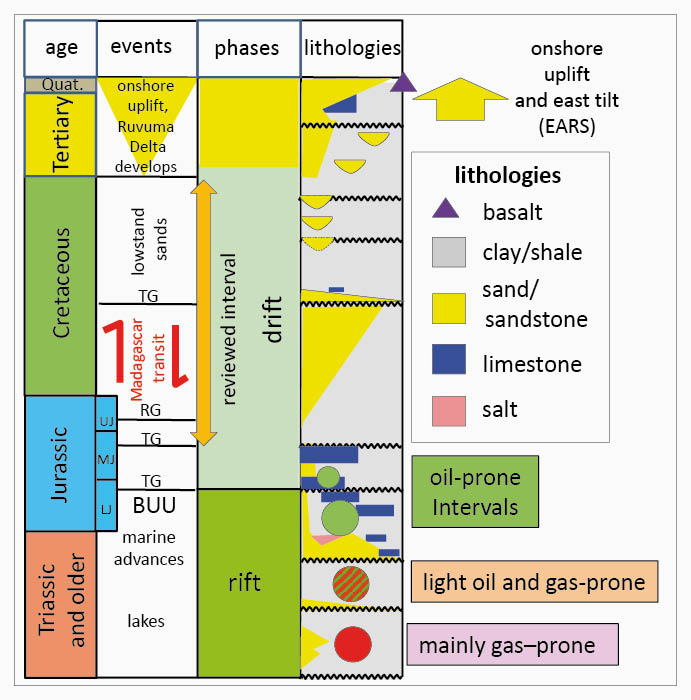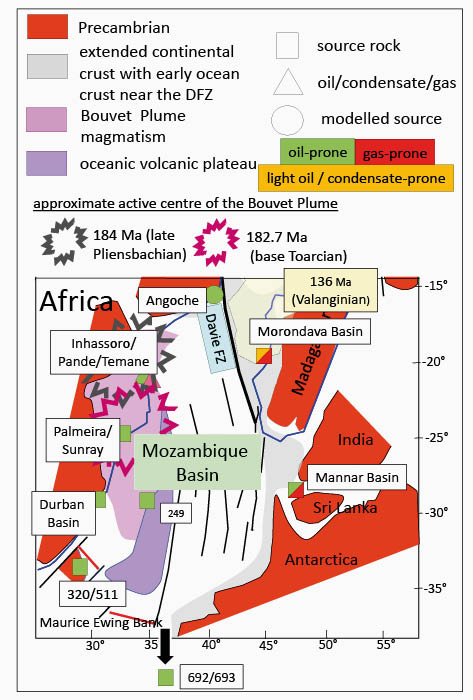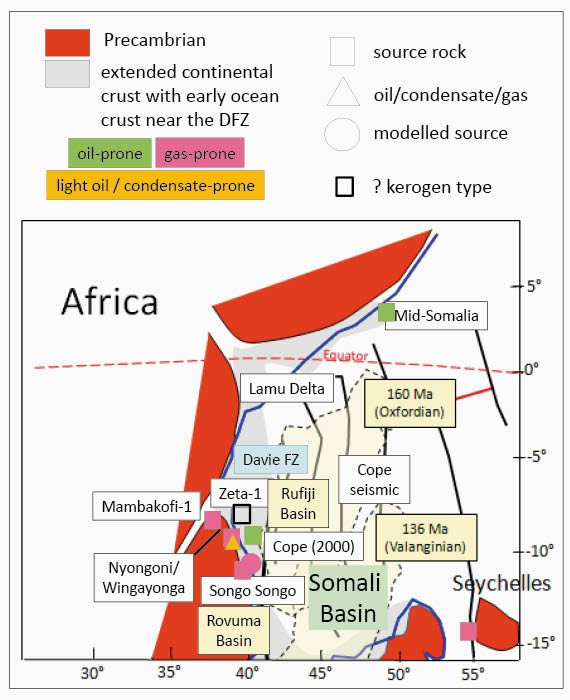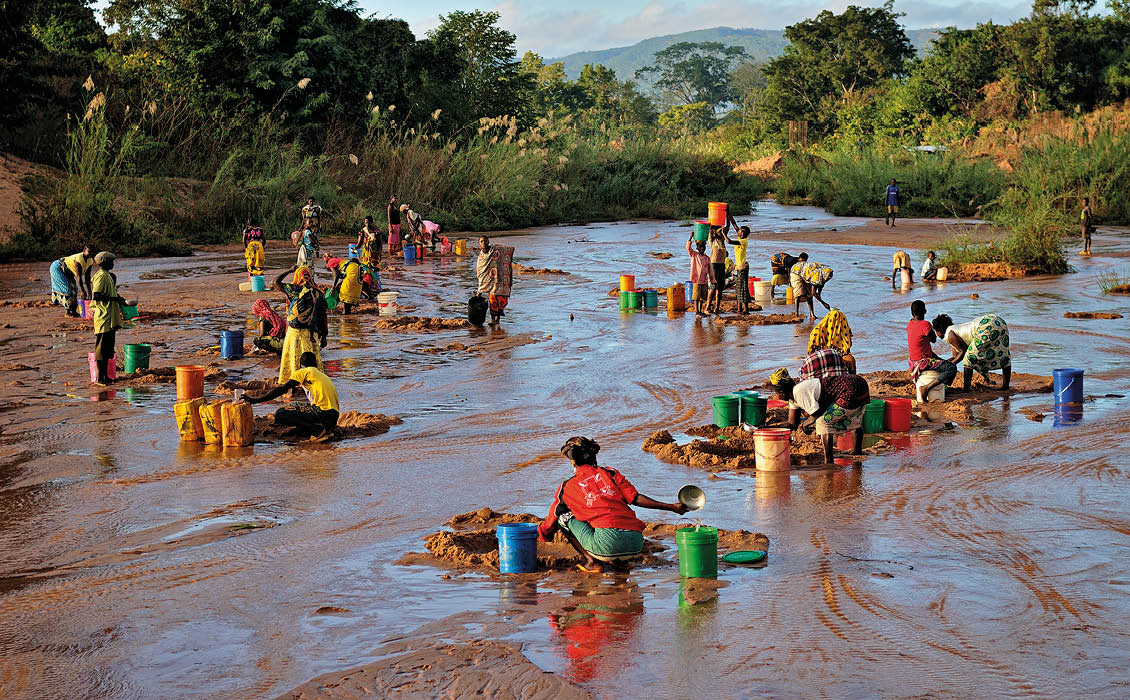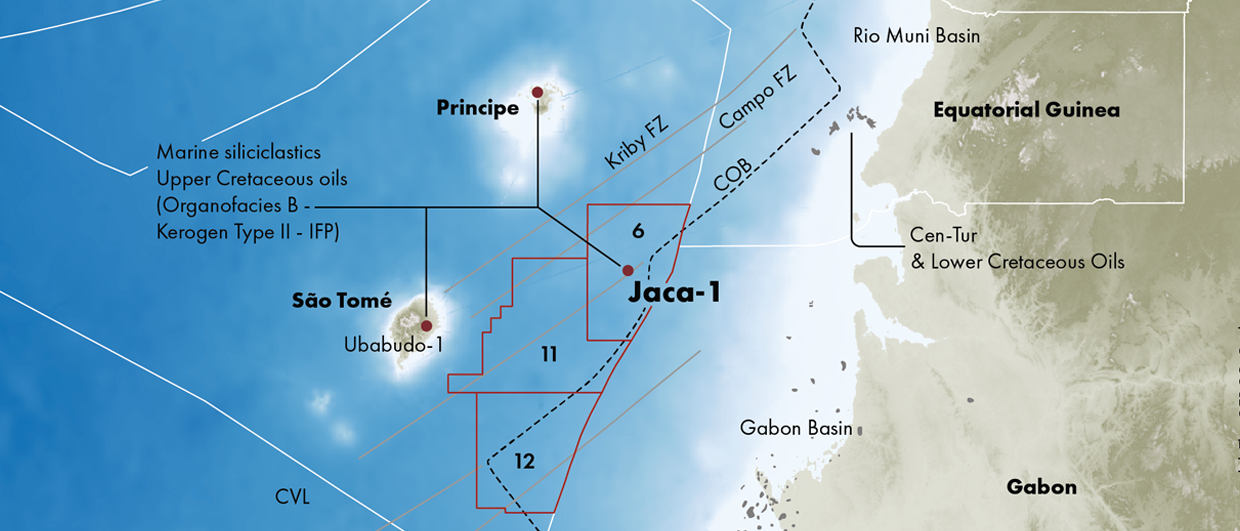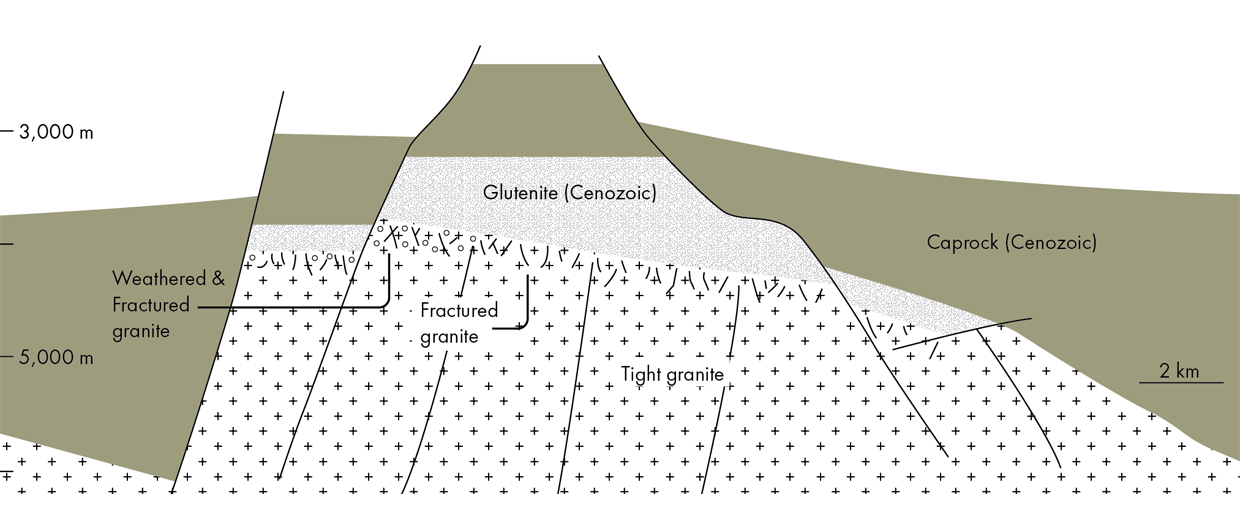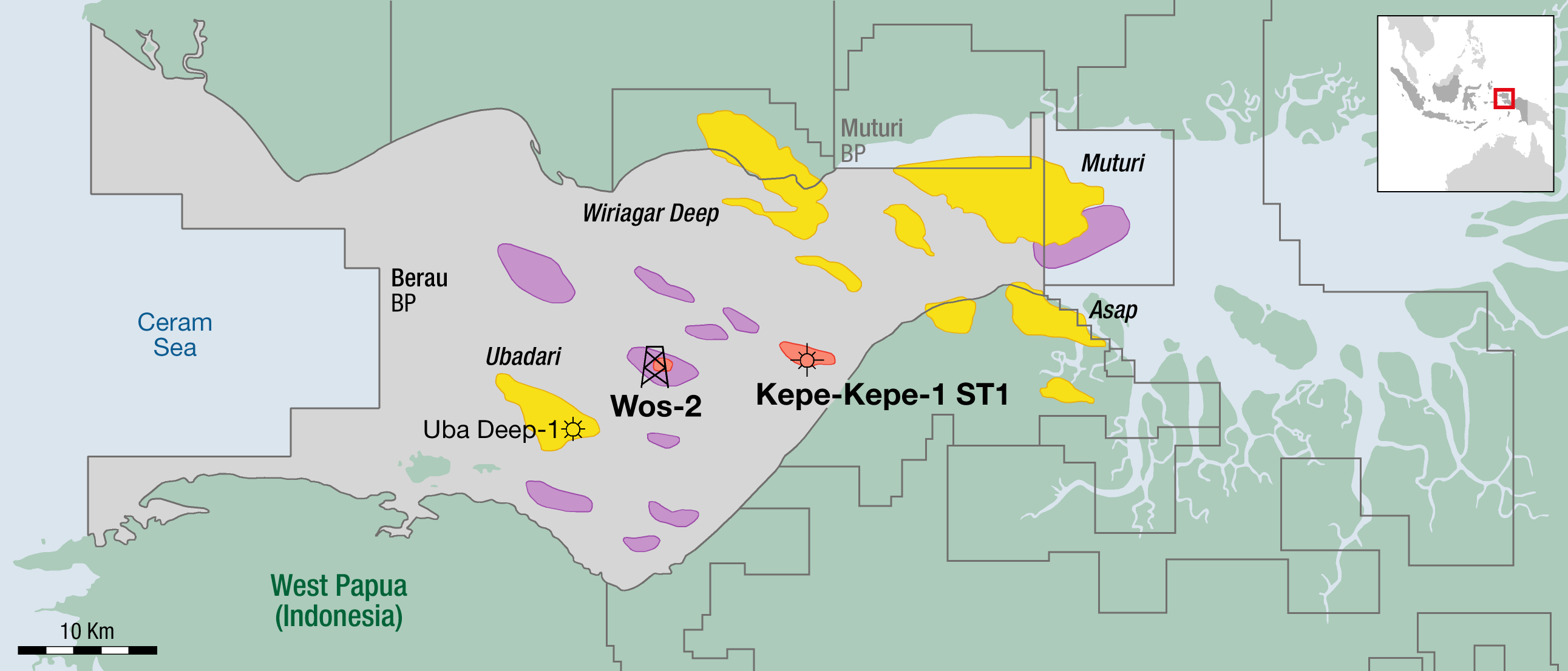“…, while at the same time respecting their freedom to consider contrasting views and data. One can be entertained by iconoclasts espousing unique views, but we know from experience that a solid foundation of scientific investigation must support expensive exploration campaigns, …..”
(AAPG Explorer, May 2020, p. 24).
Coastal and offshore East Africa hosts a variety of long recognised and well described source rocks (Boote and Matchette-Downes, 2009). This essay expands on their observations by examining the additional potential that may be available from Cretaceous and Upper Jurassic sources. Though this interval remains poorly sampled for source rocks and no certain oil-to-source tie from it exists, the aggregated indications for the development of effective sources within it are sufficient, we believe, for this interval to be considered as potentially mainstream as any of the currently recognised sources. Nevertheless, until an unequivocal oil to source tie is established, debate regarding the source origin of some oil and gas discoveries in this region will continue. Successful outcomes to the ongoing bid rounds in offshore Somalia (Anon, 2020) and Mozambique (GeoPartners, 2020) are likely to be assisted by progress on this debate.
Tectonic Background
The investigated succession occupies the pre-Tertiary portion of the Indian Ocean drift sequence that began with the tectonism and transgressions that ended Middle Jurassic carbonate platform deposition above the Break Up Unconformity during the Bathonian and Bajocian stages (Figure 1 and Kapilima, 2003). This means that the section includes the youngest Middle Jurassic and as such it embraces all but the inception of the separation of Madagascar from Africa by way of the Davie Fracture Zone (see Reeves, 2020 and 2018 for the details of this history). Emphasis is placed on the Rovuma Delta which straddles the border between Tanzania and Mozambique as this is where the recent super-giant gas discoveries lie and where the most uncertainty exists as to the nature of the hydrocarbon source(s).
Elsewhere, limited past onshore and nearshore success in terms of commercial hydrocarbon discoveries can largely be attributed to the dearth of published regional fieldwork over the last 30 years combined with the lack of wells drilled on other than sparse 2D seismic coverage of variable quality. This lack of exploration success cannot, therefore, be used as a reliable indicator of the coastal region’s remaining yet-to-be-discovered hydrocarbon potential and in turn the distribution and quality of both mainstream and novel source rocks.
Figure 2 illustrates the Cretaceous and Upper Jurassic source records and interpretations deemed credible from the Mozambique Basin, while Figure 3 shows those from the Somali Basin. Both figures are prepared using the drift configuration released by Reeves (2018) for 120 Ma (mid-Aptian). Older Middle Jurassic and earlier source records are excluded: information on them is available from Boote and Matchette-Downes (2009). International Chronostratigraphic Chart age attributions are used (Cohen et al., 2013 updated).
The Mozambique Basin
In 2017 Loegering and Milkov suggested that Cretaceous sources were the origin of both the light oil in the Inhassoro Field and the gases in all three of Sasol’s fields which are located onshore in southern Mozambique. A weakness in their source age conclusion was that, apart from the Palmeira and Sunray wells in the far south (Coster et al., 1989), quality sources of this age remain to be found (see Mussa et al., 2018) and an older, and presumably richer, source could be argued as being more likely (Boote et al., 2017). Reconstructions published by Mueller and Jokat (2019) imply that an older source possibility is unlikely given that they position ocean crust or highly extended continental crust beneath the region of the fields with the former originating at magnetic anomaly M38n (164 Ma, Callovian). Reeves (2020) shows the Bouvet Plume with its associated magmatism tracking southwards across this region from 184 Ma (late Pliensbachian) following its first impact in the Beira region down the eastern side of what is now the onshore Mozambique Basin clearing the present coastline at the end of the Lower Jurassic during the Toarcian. On 29 July 2020, in a personal communication, Colin Reeves wrote: “there’s hardly a room big enough for the elephant that was the Bouvet Plume so it’s hardly meaningful to pin it down too precisely. My ‘star’ [see Figure 3] is nominally 1,000 km in diameter, but its effects were experienced far away”.
Reeves (2020 and 2018) also requires the existence of a continental fragment beneath the same portion of onshore Mozambique to ‘best fit’ the pre-break-up configuration of Mozambique with Antarctica. This fragment, which he names Limpopia and which was once part of Antarctica, could theoretically host pre-plume sources, but it is difficult to envisage how a Limpopian source of this age could survive to contribute to Sasol’s fields because of the high heat flow, hydrothermal circulation and uplift tectonics commonly associated with large plume heads (for information on plume head environments see Cagney and Lithgow-Bertelloni, 2016). It is considered reasonable in these circumstances to concur with the source view of Loegering and Milkov (2017) and to go on to predict that Cretaceous and Upper Jurassic sources could be regionally significant in southern Mozambique and thus also in northern South Africa. Strong support for offshore, Southern Ocean-positioned, source intervals of this age is provided by records of Cretaceous and Upper Jurassic sources at DSDP sites 249, 330/511, 692/693 (Figure 2 and Higgins and Sofield, 2011). Other established examples are the mid-Cretaceous sources of the offshore, south coast basins of South Africa (not plotted on Figure 2, but see, for example, Van Der Spuy, 2003) and the likely Upper Jurassic sourced oil of the Durban Basin (Singh and McLachlan, 2003). Setoyama and Kanungo (2020), condense these observations, in a paper highlight for their review of the Southern Ocean’s DSDP/ODP results, to just: “probable high primary productivity in the Early Cretaceous in the Southern Ocean”.
Using Spectrum’s ‘top soft kick/base hard kick’ seismic interpretation methodology, Intawong et al. (2019) argued for the development of both post- and pre-Turonian oil-prone sources in the offshore Angoche Basin (central northern Mozambique), finding evidence for spatially associated oil slicks.
Southern Somali Basin
Source attributions are complicated in this basin by the presence of established older Middle Jurassic and earlier sources, the complexity of the geology associated with the transit of Madagascar and uncertainty offshore relating to the younger Tertiary thermal and tectonic events (Sayers, 2017). A further complication is that the main gas source was not encountered in the Rovuma Basin gas discovery wells (Sayers, 2017). Mkuu (2018), however, describes from the deepwater Zeta-1 well in the Rufiji Basin Cenomanian TOCs which peak at just over 3% and which at the base of the analysed section are associated with amorphous organic matter (AOM). Pyrolysis records were not included and it is unknown whether these kerogens are oil- or gas-prone. Vitrinite reflectance values were in the range 1.2-1.6% Ro. Deep section penetrations everywhere are apparently age-limited, with company press releases suggesting the oldest encountered section is no older than Valanginian.
Basin modelling allows source predictions but, as is invariably the case in complex settings, multiple possibilities arise (Rego et al., 2019). Fortunately, modern, better quality seismic is exposing the tectonic complexities and volcanicity associated with the Davie Fracture Zone (see for example Sauter et al., 2018) and there is a case, in such circumstance, for selecting as the most likely case the solution that yields the youngest modelled and, therefore, the least perturbed kitchen. Preferred here then is the opinion of Van Itterbeeck et al. (2019) who write: “therefore the simplest explanation to explain the offshore gas discoveries is to link it to a Cretaceous, lean, terrestrial kerogen source rock”. Johnstone (2016) suggested the Lower Cretaceous might be the source of the gas as his modelling indicated older sources were fully matured before the young, gas-bearing structures were formed. However, acceptance of a Lower Cretaceous source does not mean that contributions from older sources can be discounted.
Older Cretaceous, primarily gas-prone sources are known from the onshore Rovuma Delta in Mozambique (Edwards, 2005 and Hancox et al., 2002) and from the Rufiji Delta in the Songo Songo Field (see Kagya, 2000 and Ntomola and Abrahamsen, 1987). The latter are a marginal source as regards their quality, but as the fetch area for the field is large (see Rego et al., 2013) such a source could be reasonably accepted as a viable major charge to the field. Associated condensates are believed to have originated from a humic marine shale or lacustrine source according to Jarvie (2003). Barremian mixed Type II-III affinity organic matter is illustrated in a thin section by Einvit-Heitmann et al. (2016) from the onshore Mandawa Basin to the south in a setting located between the Rovuma and Rufiji deltas.
Released seismic reveals the base Cretaceous surface offshore forms a strong unconformity (Sansom, 2018) that is overlain by multiple, eastward flowing progrades, some of which became the gas field reservoirs. Observations using Google Earth for the region between the Mandawa Basin to the Rovuma River indicate the basal Cretaceous surface onshore to be cutting back westwards across the Jurassic to overlie Precambrian basement. Little is known about the facies of the ensuing thick older Cretaceous cover, but the relief of this region, currently expressed in the form of the strongly upstanding escarpment to the Makonde Plateau (Figure 4), should be adequate to determine by sample collection whether this delta head region was a further source of Type III kerogens of the type encountered just to the south in northern Mozambique. The overall Basin’s dip configuration allows such Makonde Plateau region sediments to be drawn during lowstands or flooding events offshore and to be incorporated into the overall reservoir succession. Such settings would be analogous to those in the Kutei Basin of Kalimantan (Indonesia) where mangrove-associated kerogens have been drawn down to mature in deepwater settings to subsequently expel hydrocarbons with burial (Ito and Taguchi, 1990 and others).
Equally little is known about the overall source content of the Lower Cretaceous and Upper Jurassic section of the onshore Rufiji Delta. Google Earth imagery indicates the Delta to have had a long and complex history with multiple river mouths. Inland the source of the Mambakofi-1 gas discovery is anecdotally rumoured to be the Upper Jurassic (Figure 3 and Anon, 2016). Methane associated with a hot spring at Nyongoni to the east is of thermal origin, the overall sample composition of which according to Kraml et al. (2014) best fits derivation from a marine source. A thick succession of bituminous sandstones of Lower Cretaceous age was intersected in the nearby Wingayongo borehole (Mbede and Dualeh, 1997), though this bitumen, together with the methane, could be products from an older Jurassic, marine source. Oil seeps are present, but due to severe biodegradation their source origin is unclear (see Mpanju and Phelp, 1994).
Considerable significance was attached some years ago to reported high TOCs within Maastrichtian to Campanian black shales in two Kimbiji area wells (see for example Cope, 2000). These high TOC records are no longer considered valid (see Whaley, 2007 for example). This region lies within the influence of the Rufiji Delta and these shales may be pointers to a new updip and thus onshore gas play, provided there is sufficient cover to fully mature them.
Northern Somali Basin
Effective Cretaceous and Upper Jurassic sources are absent from the coastal zone well further north, due to the depth of much of this section below the Lamu Delta, until mid-Somalia where Rodriquez et al. (2019) found, again applying Spectrum’s ‘top soft kick/base hard kick’ model, indications from seismic to suggest that oil-prone Cretaceous and Upper Jurassic sources are developed in deep water with modelling suggesting that some of these intervals are likely to be mature. Further north and north-west Middle East petroleum systems, for example those related to the Madbi Formation, predominate (As-Saruri and Sorkhabi, 2016).
Cope (2000) includes a deepwater seismic profile from the Mafia deep offshore basin that displays bedding-parallel amplitudes in the interval below the Upper Cretaceous (Layer 2) that visually resemble those attributed to source horizons by Spectrum in Somalia. The location of this line is unknown, but this basin covers the region of the new deepwater gas finds from Tanzania. Should Spectrum’s source prediction technique result in success, it offers the immediate possibility of rapidly defining new areas of Cretaceous and Upper Jurassic source potential. Most exciting for the region’s oil potential would be the opening of a new younger Cretaceous, oil-prone source section should the Angoche predictions from the post-Turonian succession be found to be correct.
Unexpectedly Widespread
In addition to Antarctica, records for Cretaceous and Upper Jurassic sources exists in the Mannar Basin of Sri Lanka (Kularathna, 2020), the central Morondava Basin of Madagascar (Tranter, 2017) and the Seychelles (Plummer, 1994). Their extent indicates source rocks of this age to be regionally developed along both margins during the Cretaceous and Upper Jurassic where conditions allow them to accumulate. Collectively, these records could outline a northern continuation towards the Middle East of the Lower Cretaceous region of “probable high primary productivity” in the Southern Ocean highlighted by Setoyama and Kanungo (2020).
Examination of Figures 2 and 3 indicates that most of the gas records attributed here to the Cretaceous and Upper Jurassic are associated with the interaction zone along the Davie Fracture Zone between Africa and Madagascar. Two explanations are possible for this gas concentration. The first possibility is that Lower Cretaceous and Upper Jurassic gas-prone sources are concentrated in this region because of hinterland uplift, which delivered by way of rejuvenated rivers, abundant gas-prone kerogens diluting in the process the oil-prone kerogens that would otherwise have accumulated in a predominantly oil-prone basin.
The second possibility is that older sourced hydrocarbons survived largely intact the events associated with the transit of Madagascar enabling them to expel gas by pressure release as the pay-bearing, delta front collapse structures formed (Rego et al., 2019). This possibility though is not without problems and is considered less likely, as previously noted, because of the risk of losing earlier generated hydrocarbons to tectonism as the Davie Fracture Zone developed. In less active tectonic settings onshore, older established sources could be involved giving rise to hybrid Petroleum Systems as exampled by the oil seeps found along the Tanzanian coast from the mouth of the Rovuma River northwards as far as the Songo Songo Field (Rego et al., 2013). This could also be the explanation for the condensates at Songo Songo.
The East Africa-wide spread of potential Lower Cretaceous and Upper Jurassic source possibilities was unexpected. Given the revival earlier this year of the concept that oil-prone, source rock deposition can be enhanced by the nutrients supplied to sea life from ash falls during major volcanic episodes (Parker, 2020), the explanation may lie in the widespread volcanicity during this time:
- Volcanism on the necessary scale existed in the Lower Cretaceous and Upper Jurassic during the opening of the Mozambique and Somali basins and along the Davie Fracture Zone (Sauter et al., 2018).
- Magmatism was augmented in the Mozambique Basin by Africa’s passage northwards across the Bouvet Plume (Figure 2 and Reeves, 2020).
- In DSDP 249 the source rocks are described as being associated with volcanic sediments (Girdley, 1974). This possibility is encouraging for Comoros exploration where the entire country is underlain by Lower Cretaceous ocean crust (Cohen and Marshall, 2019).
Much remains to be accomplished before the extent and quality of the Cretaceous and Upper Jurassic source systems can be conclusively documented. Particularly important is establishing the source quality of the onshore outcrops, for example the Makonde Plateau, as this will allow their geochemistry to be related to the currently rapidly progressing understanding of the offshore sedimentary fabric. This work has begun in the Mandawa Basin of Tanzania (Einvik-Heitmann, 2016 and others), but their primary objective appears to have been the sedimentology of the onshore equivalents of the offshore gas-bearing, reservoir sands. The result is that large areas of older Cretaceous and Upper Jurassic outcrops remain devoid of source-quality records. Equivalent published records for the offshore wells barely exist.
More Investigation Needed
A limitation for this projected source interval is that it will lie, except when fully developed and mature, in the nearshore and onshore Mozambique and Rufiji basins, and possibly additionally the Rovuma Basin, in current deepwater settings. However, migration products could have moved up dip into shallower waters. This deepwater region may be the true location of the Cretaceous charge into Sasol’s fields. Such migration could also be the explanation for the oil shows within the Cretaceous section penetrated by the Ironclad-1 well in the Mozambique portion of the Rovuma Basin (Law, 2011).
References
- Anon, 2020. Somalia: a final frontier opens up. GEOExPro, September 2020, p. 8.
- Anon, 2016. Exploration update – Tanzania. GEOExPro, June 2016, p. 65.
- As-Saruri M. and R. Sorkhabi, 2016. Petroleum basins of Yemen. GEOExpro, April 2016, p. 38-42.
- Boote D.R.D, and 2 others, 2017. Permo-Triassic Petroleum Systems of the East African Coastal Basins. AAPG/SEG International Conference and Exhibition, London, England, October 15-18, 2017. AAPG Search and Discovery Article #90310.
- Boote D.R.D. and C. J. Matchette-Downes, 2009. Extinct and near-extinct Petroleum Systems of the East African continental basins. New Concepts for the Oldest Continent, 6th PESGB-HGS Conference, pp 7.
- Cagney N. and C. Lithgow-Bertelloni, 2016. Dynamics and excess temperature of a plume throughout its life cycle. Geophysics Journal International, 205, 3, p. 1574-1588.
- Cohen C. and S. Marshall, 2019. Comoros Islands multi-billion barrel deepwater prospect potential. GEOExPro, October 2019, p. 70-73.
- Cohen K.M. and 3 others, 2013 updated. The ICS International Chronostratigraphic Chart. Episodes, 36, 3, p. 199-204.
- Cope M., 2000. Tanzania’s Mafia deepwater. Oil and Gas Journal, 14/8/00, p. 40-41, 44-46 and 48-49.
- Coster P.W. and 2 others, 1989. Mozambique: a new geological framework for hydrocarbon exploration. Journal of Petroleum Geology, 12, 2, p. 205-230.
- Edwards H., 2005. Exploration opportunities within the Mozambique Rovuma Basin. Mozambique 2nd Licensing Round, Maputo, July 2005.
- Einvik-Heitmann V., 2016. Sedimentology, stratigraphy, petrology and diagenesis of an Early Cretaceous drill core. Mandawa Basin, Coastal Tanzania. Master Thesis, Department of Geosciences, University of Oslo, pp. 151 + appendices.
- GeoPartners, 2020. Mozambique 6th licensing round. Advertisement in GEOExpro, September 2020, p. 19.
- Girdley W.A. 1974. Carbon and carbonate analyses, Leg 25. In: Initial Reports of the Deep Sea Drilling Project. Volume 25 covering Leg 25, Vallier T.C. and S.M. White (editors), US Government Printing Office, Washington DC, US, appendix III, p. 841 plus table 1.
- Google Earth. earth.google.com/web/.
- Hancox P.J. and 2 others., 2002. Sequence stratigraphic analysis of the Early Cretaceous Maconde Formation (Rovuma basin), northern Mozambique. Journal of African Earth Sciences, 3*4, 3-4, p. 291-297.
- Higgins R. and M. Sofield, 2011. East Africa transform margin – the view from Tanzania and Madagascar Africa: a Legacy of Exploration & Discovery. 10th PESGB/HGS Conference, 7-8 September 2011, p. 23.
- Intawong A. and 3 others , 2019. Oil prospects in the Mozambique Channel: where incipient subduction meets passive margin. First Break, 37, March, p. 75-81.
- Ito Y. and T. Taguchi, 1990. Petroleum Geology and Hydrocarbon Source Rocks in Mahakam Delta, East Kalimantan, Indonesia. Journal of the Japanese Association for Petroleum Technology, 55, 1, p. 54-65.
- Jarvie D., 2003. East Africa Rift Petroleum Systems. Conference on the Petroleum Potential and investment Opportunities in East Africa. EAPC ’03, Nairobi, 5-7 March 2003), p. 31-43.
- Johnstone D., 2016. A source evaluation of the Rovuma Basin, Mozambique. AAPG/SEG International Conference and Exhibition, Barcelona, 3-6 April 2016.
- Kagya M., 2000. Hydrocarbon potential of the deep sea off Tanzania coastal basins as indicated by geochemistry of source rocks and oils from Songo Songo gas field. In: Garg A.G., V. Banerjie, S. N. Swamy and P. Dwivedi (editors). Petroleum Geochemistry & Exploration in the Africa-Asian Region. 5th International Conference & Exhibition, 25-27 November 2000, Oil and Natural Gas Corporation Ltd. New Delhi, India (Afro-Asian Association of Petroleum Geology), p. 109-116.
- Kapilima S., 2003. Tectonic and sedimentary evolution of the coastal basin of Tanzania during the Mesozoic times. Tanzanian Journal of Sciences, 29, 1, p. 1-16.
- Kraml M. and 6 others, 2014. Geochemical and isotopic results of recent surface exploration in Rufiji area, Tanzania. Proceedings 5th African Rift Geothermal Conference, Arusha, Tanzania, 27-31 October 2014.
- Kularathna E. K. C. W. and 3 others, 2020. Play distribution and the hydrocarbon potential of the Mannar Basin, Sri Lanka. Journal of Petroleum Exploration and Production, 10, p. 2225-2243.
- Law C., 2011. Northern Mozambique true wildcat exploration in East Africa. AAPG 2011 Annual Convention & Exhibition 10-13 April 2011, Houston, Texas. AAPG Search and Discovery, http://www.searchanddiscovery.com/documents/2011/110157law/ndx_law.pdf.
- Loegering M.J. and A.V. Milkov, 2017. Geochemistry of petroleum gases and liquids from the Inhassoro, Pande and Temane fields onshore Mozambique. Geosciences, 7, 33, pp. 12.
- Mbede E.I. and A. Dualeh, 1997. The coastal basins of Somalia, Kenya and Tanzania. In: Selley R. C. (editor). African Basins. Sedimentary Basins of the World 3, Elsevier, chapter 10, p. 211-233.
- Mkuu D.E., 2018. Palynological, palynofacies, thermal maturity and burial modelling analyses of the Cretaceous to Cenozoic sediments from a series of Tanzanian onshore and offshore boreholes. PhD thesis, University of Southampton, pp. 286.
- Mpanju F. and R.P. Phelp, 1994. Organic geochemical characterization of bitumens, seeps, rock extracts and condensates from Tanzania. Organic Geochemistry, 21, 3-4, p. 359-371.
- Mueller C. O. and W. Jokat, 2019. The initial Gondwana break-up: a synthesis based on new potential field data of the Africa-Antarctica Corridor. Tectonophysics, 750, p. 301-328.
- Mussa A. and 3 others, 2018. Characterization of organic matter from a stratigraphic sequence intercepted by the Nemo-1X well, Mozambique: potential for hydrocarbon generation. Energy Exploration & Exploration, 36, 1, p. 1-15.
- Ntomola S. J. and K. A. Abrahamsen, 1987. Source rocks and hydrocarbon distribution in the Coastal Basin, Tanzania. In: “Petroleum Geochemistry and Exploration in the Afro-Asian Region”, Kumar R.K., P. Dwivedi, V. Banerjie and V. Gupta (editors), Proceedings of the First International Conference on Petroleum Geochemistry and Exploration in the Africa-Asian Region, Dehradun 25-27 November 1985, A.A. Balkema, Rotterdam and Brookfield, p. 119-127.
- Parker D.M., 2020. Some geoscientists are concluding that organic enrichment of rock is by volcanic ash fall. The Implications are dramatic; but are they probable? AAPG Search and Discovery, http://www.searchanddiscovery.com/pdfz/documents/2020/70403parker/ndx_parker.pdf.html.
- Plummer P.S., 1994. Mesozoic source rocks and hydrocarbon potential of the Seychelles offshore. Journal of Petroleum Geology, 17, 2, p. 157-176.
- Reeves C.V., 2020. Gondwana. http://www.reeves.nl/gondwana.
- Reeves C.V., 2018. The development of the East African margin during Jurassic and Lower Cretaceous times: a perspective from global tectonics. Petroleum Geoscience, 24, 1, p. 41-56.
- Rego M. C. and 3 others, 2019. Using basin modelling to examine the origin of the hydrocarbons within the deepwater Rovuma Basin of Tanzania, Mozambique and the Comoros. Africa is back smarter, stronger, better, PESGB-HGS Africa E&P conference, London, 1-2 October 2019, p. 161-162.
- Rego M.C. and 2 others, 2013. Gas success along the margin of East Africa, but where is all the generated oil?, Search and Discovery article #10488, http://www.searchanddiscovery.com/documents/2013/10488pereira/ndx_pereira.pdf
- Rodriquez K. and 3 others, 2019. The illusive oil-prone gem. GEOExPro, March 2019, p. 42-46.
- Sansom P., 2018. Hybrid turbidite–contourite systems of the Tanzanian margin. Petroleum Geoscience, 24, 3, p. 258-276.
- Sauter D. and 5 others, 2018. Intraplate deformation of oceanic crust in the West Somali Basin: insights from long-offset reflection seismic data. Tectonics, 37, 2, p. 568-603.
- Sayers N., 2017. Impact of Tertiary tectonic activity on the Petroleum System, offshore Tanzania/Mozambique, East Africa. 16th African E&P Conference, New Thinking. New Technologies, New Hydrocarbons, PESGB-HGS, 31 August-1 September 2017.
- Setoyama E. and S.Kanungo, 2020. Mesozoic biochronostratigraphy and paleoenvironment of the South Atlantic: a revised framework based on 20 DSDP and ODP deep-water sites. Journal of South American Earth Sciences, 99, April.
- Singh V. and I. McLachlan, 2003. South Africa’s east coast frontier offers untested mid to deepwater potential. Oil and Gas Journal, 2 June 2003, p. 40-44.
- Tranter N., 2017. Offshore Madagascar: hydrocarbon potential in frontier basins. Finding East & Southern Africa Oil & Gas, Finding Petroleum. The Geological Society, London, 23 February 2017.
- Van Der Spuy D. 2003. Aptian source rocks in some South African Cretaceous basins. In: Arthur T.J., D.S. Macgregor and N.R. Cameron, 2003. Petroleum Geology of Africa New Themes and Developing Technologies. Geological Society Special Publication 207, p. 187-202.
- Van Itterbeeck K.J. and 2 others, 2019. Oil along the East African margin: a regional 3FD integrated charge modelling approach. “Africa is back smarter, stronger, better”, PESGB-HGS Africa E&P conference, London, 1-2 October 2019, p. 22-23.
- Whaley J., 2007. East African exploration: myths, myopia and misinformation? GEO ExPro, October 2017, p. 16-20.



